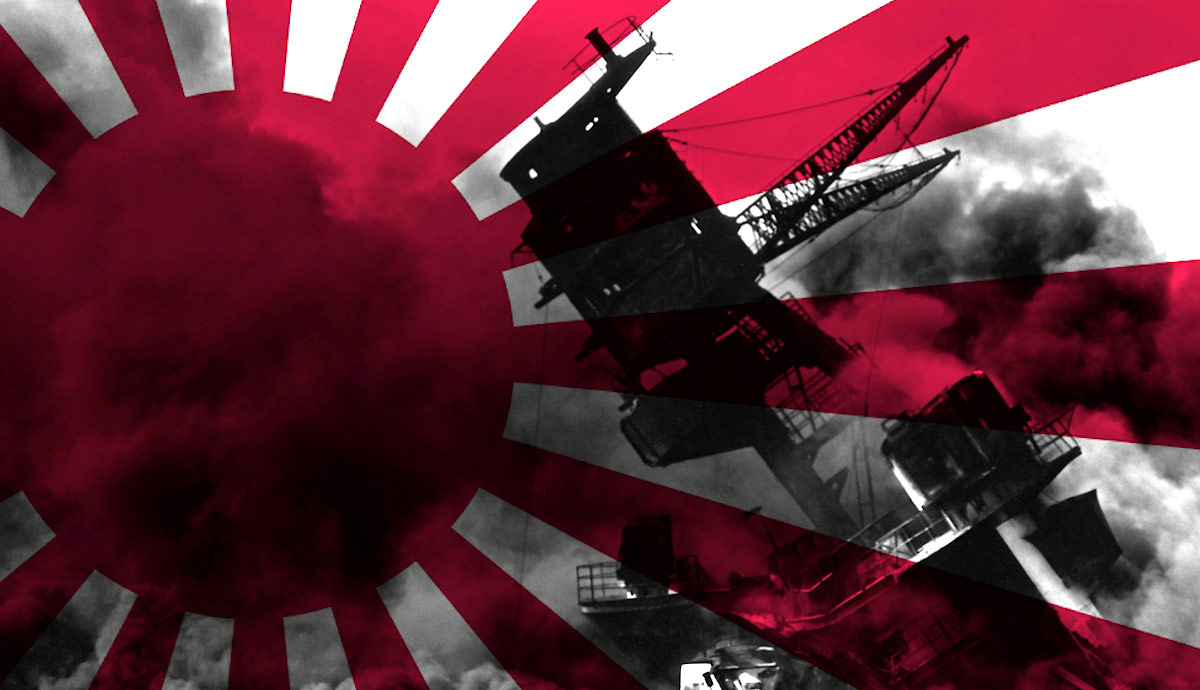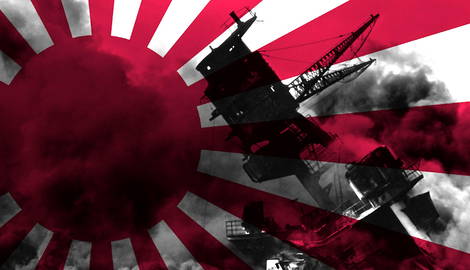
In the early hours of the morning of December 7, 1941, a large Japanese fleet involving no fewer than six aircraft carriers snuck into position north of the island of Oahu. In the port of Pearl Harbor, which serves the city of Honolulu, a large American fleet was moored.
This was the Japanese target. With one quick action, they intended to strike a devastating blow to the American Navy by sinking and demobilizing a sizable portion of its fleet.
As the sun rose over the Pacific, the Japanese launched hundreds of planes and caught the Americans by surprise. For just over an hour, the Japanese forces wreaked havoc, destroying ships in the harbor and planes on the ground.
Then, the Japanese left as quickly as they arrived. The surreal aftermath was filled with the screams of wounded and desperate men. Smoke filled the air, and people struggled to rescue their comrades from a watery grave.
The aftermath would also bring the United States and all its industrial might into the Second World War.
Background to the Attack on Pearl Harbor

The Japanese and the Americans had been stuck in a difficult diplomatic relationship for much time before the two nations went to war with each other. American territorial expansion since the 1890s with the annexation of the Philippines as well as Hawaii had put the Japanese on edge, as they saw these places as being within the Japanese sphere of influence.
American sanctions on Japan had also strained relations. The United States used sanctions as a way of protesting against Japanese expansion in Southeast Asia. Of particular importance was oil, which America stopped sending in July 1940 once Japan had already declared war on the other Allies. Another nail in the coffin of a peaceful resolution was the fact that Japan was at war with China, and the United States was arming China against their imperialist foe.
Negotiations took place between the two countries but no agreement could be reached. In the spring of 1941, the Japanese military began planning for a quick and overwhelming action that would culminate in the raid on Pearl Harbor.
Seeing the entrance of the United States into the war as inevitable, the Japanese took a decision to strike a decisive blow at the American fleet.
The Attack

On November 26, 1941, the Japanese fleet set sail. It consisted of six aircraft carriers carrying 414 aircraft. These would be the prime weapons to be used to destroy the American assets in the harbor. Aiding them would be 28 submarines. In support of the attack components, the Japanese fleet also consisted of two battleships, three cruisers, eleven destroyers, and eight tankers.
From a position 275 miles north of Oahu, 360 planes were launched in the first wave and flew south to destroy their targets moored in the Pearl Harbor port. Sharing command at Pearl Harbor, Admiral Husband E. Kimmel and Lieutenant General Walter C. Short had been warned of the possibility of a Japanese attack, and they had taken defensive measures. Radars had been set up, and planes were moved to Wheeler Airfield, where they were safer. None of the measures taken would prove to be anywhere close to adequate.
Despite the warnings, there was no clear evidence that any attack was imminent, and neither the commanders nor anybody in Washington had significant knowledge of any Japanese preparations. For the Americans, the day started as any other day on moderate alert. The ships had been ordered to be moored in the harbor, and a significant number of seamen had been granted shore leave.

Had the commanding officers taken the extra step of reconnoitering the north of the island, perhaps they would have understood the danger they were in. But this step had been omitted.
On the morning of the attack, Washington decoded a message from the Japanese authorities that the ambassadors to the United States wished to conduct a meeting with the American secretary of state. This meeting was to be scheduled for noon, which would have been 7 am in Hawaii, less than an hour before the attack was to commence. This was convincing evidence that the Japanese intended to declare war.
The message, however, was delayed and was only received by the War Department between 9 am and 10 am. By the time the message got through to Pearl Harbor, the attack had already begun.
Meanwhile, in Hawaii, evidence of an imminent attack was ignored, disregarded, and not acted upon. More than one incident involving Japanese submarines was reported, but Kimmel wanted to wait for confirmation before taking any action. After the Japanese had launched their aircraft, they were picked up on radar, but the radar operator was told to ignore the swarm of planes he saw, as a flight of B-17s was scheduled to fly past around that time, and those in command assumed the Japanese planes were the scheduled flight of bombers.
The Opening Shots of the War

At 7:55 am, the first Japanese plane was spotted above Pearl Harbor. By then, it was far too late for the Americans to prepare any effective defense. Within seconds, hundreds of Japanese planes were wreaking havoc, attacking ships in the harbor, and American planes were still on the ground, grouped in tight formations. The surprise and devastation were overwhelming, and any defense mounted by the Americans was done by quick-thinking individuals rather than by any command from the top.
The response from individual soldiers, sailors, and pilots was admirable. Despite the lack of significant effect it may have had on the Japanese attack, many lives were saved by alert individuals. One such man was Doris “Dorie” Miller, a Messman Third Class who served aboard the USS West Virginia. He helped move the wounded captain to safety before taking up the reins of a .50 caliber browning and firing it until it was out of ammunition. As the ship sank, he moved wounded sailors to the upper decks where they could be saved. His impact on saving lives was noticed, and he was awarded the Navy Cross for his gallantry.

The Japanese took advantage of the surprise, and flying at the front of the first attack wave were the slow and vulnerable torpedo bombers, which constituted the spearhead to destroy the American fleet. With the element of surprise, they were able to cause significant damage. A total of 183 planes took part in this group, while a second group of 171 planes attacked the US airfields.
At the primary target of Wheeler Airfield, the damage was huge. One hundred twenty-six planes sat lined up on the ground, and they were sitting ducks for the Japanese pilots. Forty-two were totally destroyed, while another 41 suffered damage. Only six pilots managed to get to their planes and take off to provide a token resistance in the air.

Meanwhile, in Pearl Harbor, the Japanese were taking care of the American fleet. Within five minutes of the attack, four torpedoes struck the USS Oklahoma, and the battleship rolled over in the shallow waters. Three more battleships were sunk. The USS Arizona suffered critical hits from a torpedo and many bombs and exploded in a massive ball of fire. The death count on this ship alone was in excess of 1,170 crew members. The USS West Virginia was also struck and sank to the bottom of the harbor, while the flagship of the Pacific Battle Force, the USS California, was critically damaged, and an evacuation was ordered as the ship was lost to the sea.

At 8:50 am, the second wave sent to attack ships in the harbor arrived and continued the process of sinking the American fleet, but it was nowhere near as successful as the first wave. Several more battleships were damaged, and a handful of destroyers were sunk, including the USS Shaw, which was split in two when it exploded. No ship escaped damage. Ten minutes after this attack began, the Japanese withdrew to the safety of their carriers to the north of Oahu.
In just over an hour, the Americans had gone from a peaceful morning to being the target of a maelstrom of noise and destruction, which disappeared as quickly as it had arrived.
Losses & Casualties

As expected, the casualty rate was skewed heavily in favor of the Japanese. They lost 29 aircraft destroyed and 74 damaged, as well as five midget submarines. Sixty-four Japanese lost their lives, and one Japanese sailor was captured.
The American losses were grievous. Of the eight battleships in the harbor, four were sunk, and the other four were damaged. Three cruisers and three destroyers also suffered significant damage. One hundred eighty-eight aircraft were destroyed, and another 159 were damaged. A total of 2,403 Americans lost their lives, while another 1,178 were wounded.
Aftermath

Despite the success of the raid on Pearl Harbor, the action was not nearly enough to blunt the spearhead of American power in the Pacific. The Japanese neglected the destruction of important service yards, and repairs on the ships began in earnest. Two battleships, the USS Nevada and the USS California, were re-floated, repaired, and put back into commission.
Battleships, however, did not prove to be the decisive factor in the Pacific Theater. American victory relied far more on aircraft carriers and submarines. Battleships were relegated mainly to shore bombardments rather than the iconic factor that would win naval engagements.
A day after the attack, US President Franklin D. Roosevelt delivered his address to the Senate, in which he described the previous day as “a date which will live in infamy.” The United States declared war on Japan. Several days later, Germany and Italy declared war on America, and the United States responded in kind.

Against the industrial might and logistic capabilities of the United States, no matter how successful the Attack on Pearl Harbor may have seemed at the time, the overall effect was minimal. In addition, it served to galvanize the American public and justify American efforts in their war against the Japanese.
Admiral Chūichi “King Kong” Hara summed it up perfectly when he stated, “We won a great tactical victory at Pearl Harbor and thereby lost the war.”










